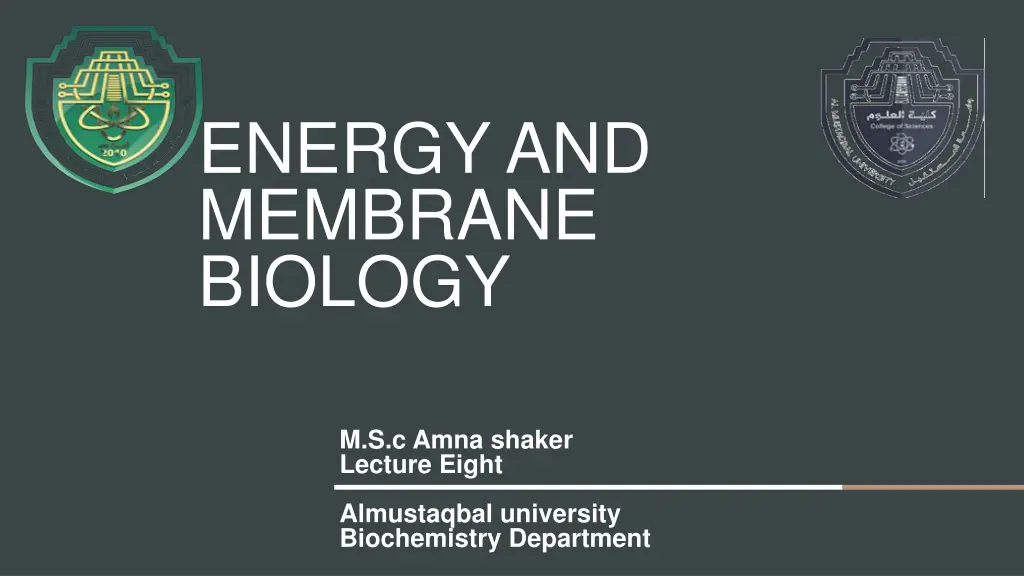
Advanced Spectrophotometric Techniques in Energy and Membrane Biology
Discover the importance of spectrophotometry and spectroscopy in analyzing substances at a molecular level. Learn about the principles and applications of spectrophotometric techniques in scientific research. Explore how spectrophotometers measure light absorption and aid in quantifying substances accurately.
Uploaded on | 0 Views
Download Presentation

Please find below an Image/Link to download the presentation.
The content on the website is provided AS IS for your information and personal use only. It may not be sold, licensed, or shared on other websites without obtaining consent from the author. If you encounter any issues during the download, it is possible that the publisher has removed the file from their server.
You are allowed to download the files provided on this website for personal or commercial use, subject to the condition that they are used lawfully. All files are the property of their respective owners.
The content on the website is provided AS IS for your information and personal use only. It may not be sold, licensed, or shared on other websites without obtaining consent from the author.
E N D
Presentation Transcript
ENERGY AND MEMBRANE BIOLOGY M.S.c Amna shaker Lecture Eight Almustaqbal university Biochemistry Department
Energy and membrane biology 2 Advanced Techniques in Energy and Membrane Biology Spectrophotometry and different types of spectroscopy are the technique that involved in identifying and quantifying the amount of a known substance in an unknown medium. Spectroscopy is the most convenient method for analysis of unknown samples both qualitatively and quantitatively with a good percentage of accuracy. Different types of spectroscopic and spectrophotometric techniques are very helpful in analyzing the samples even at sub-ppm level particularly in the field of scientific research.
3 What is a spectrophotometer? A spectrophotometer is an instrument that measures the amount of light absorbed by a sample. Spectrophotometer techniques are mostly used to measure the concentration of solutes in solution by measuring the amount of the light that is absorbed by the solution in a cuvette placed in the spectrophotometer. Scientist Arnold J. Beckman and his colleagues at the National Technologies Laboratory (NTL) invented the Beckman DU spectrophotometer in 1940.
Energy and membrane biology 4 These techniques based on the simple principle that the amount of specific radiation i.e. ray or light (photon) absorbed or reflected by the sample relative to the intensity of the incident ray/light at a particular wavelength. These techniques are using, for analyzing purity, % content in mixture, type of reactions/chemical interactions occur/absorption or reflectance of color for a colored substances/solutions are detectable and quantitatively determinable quantitative determination.
7 Most of the scientists have been using different spectroscopic and spectrophotometric techniques like Infrared spectroscopy, Raman spectroscopy, X-ray fluorescence and UV VIS spectrophotometry etc., which are playing an important role in the identification and characterization of substances, apart from this the atomic absorption spectroscopy and atomic emission spectroscopy are also being used for quantitative measurement of different substances or elements
8 Principle, instrumentation and applications of various spectrophotometric techniques A spectroscopic/spectrophotometric instrument basically consists of important components: a light/radiation source
9 Electrophysiology is a powerful tool for the study of function and connectivity in the nervous system, considerable advances through a series of electrophysiological techniques. Classic electrophysiology preparations include the axon, in which the iconic neuronal action potential , which allows for the direct insertion of metallic electrodes into the large axon to measure potential difference across the membrane, was used to discover that local anesthetic drugs act only on the inside of the neuronal membrane Since the 1970s, consistent advances in the preparation and recording of mammalian nervous tissue,
THANK YOU






















